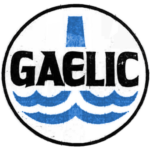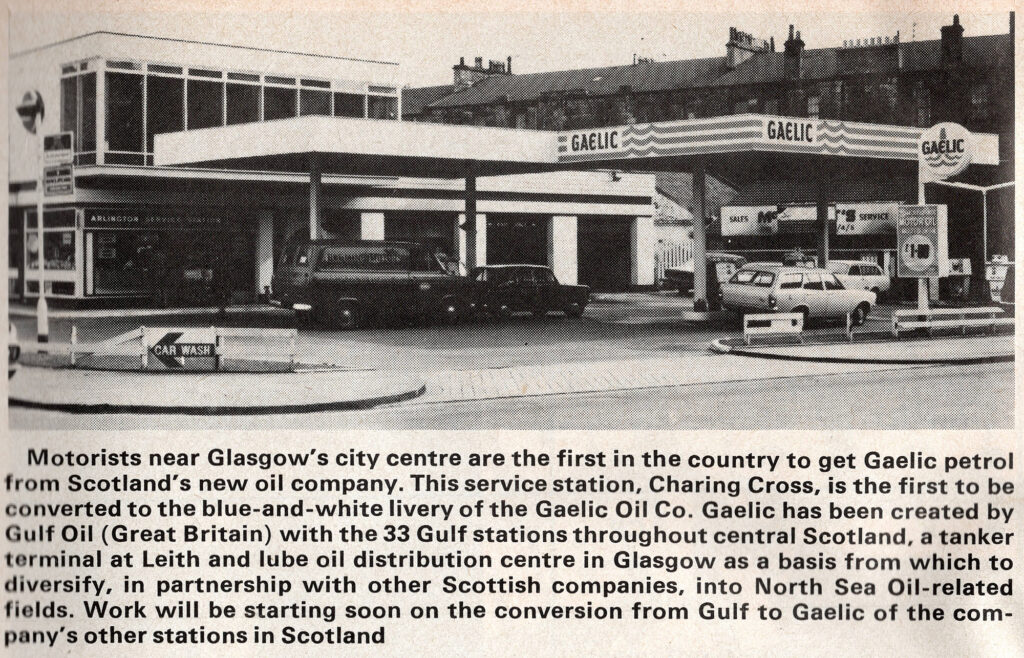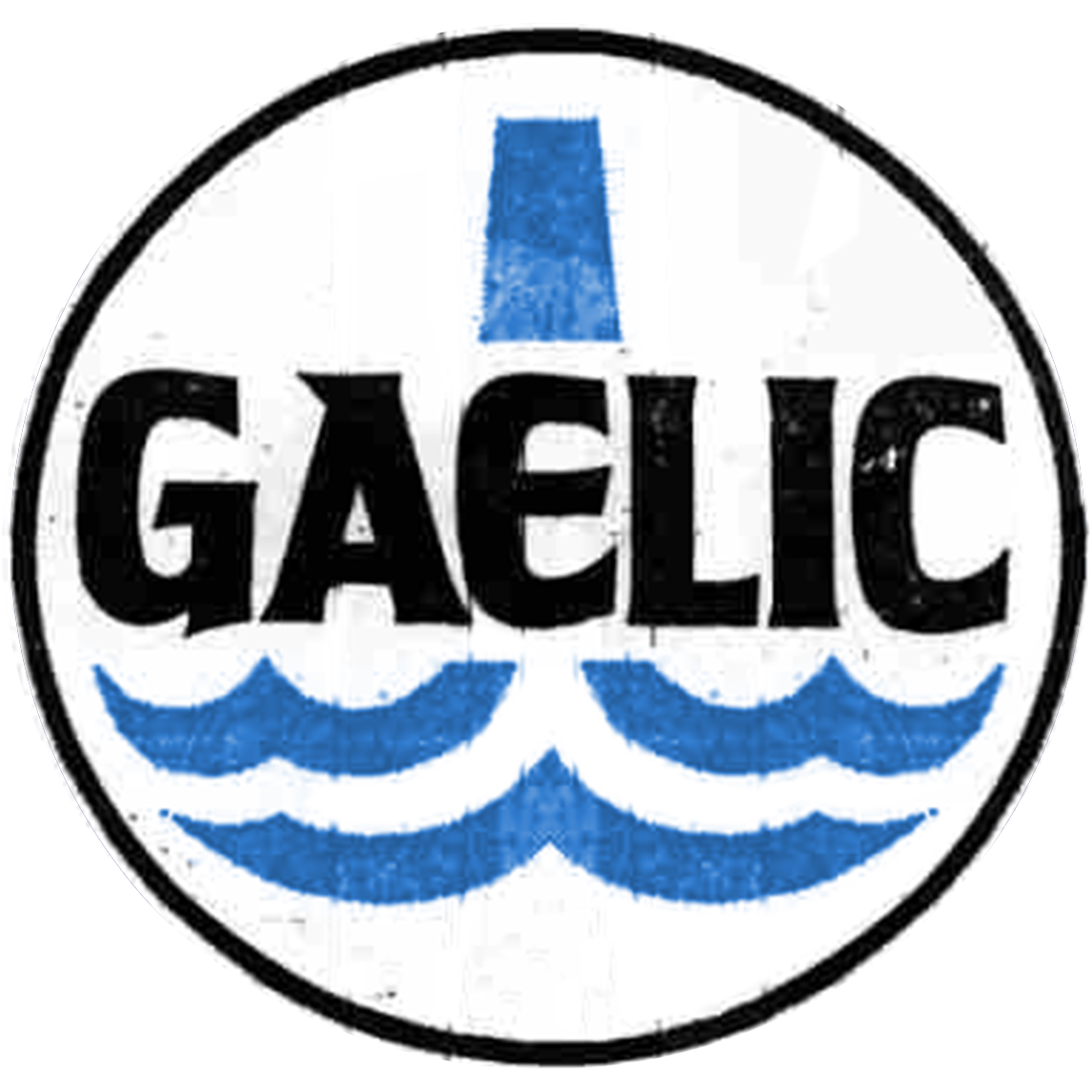
Gaelic Oil Company was created by Gulf Oil (Great Britain) in 1974, to take over Gulf’s (land-based) Scottish operations in both fuel retailing and more upstream activities. The move was noted by the New York Times as an example of a major international company recognising the trend towards increasing Scottish devolution and autonomy (the Kilbrandon Report, which suggested options for a Scottish Assembly, had been published in late 1973), and by basing the company in Aberdeen (Braemar House, Union Street), Gaelic was able to be positioned as part of the growing North Sea oil industry. Lord Clydesmuir, chair of the Scottish Council (Development & Industry) declared that Gulf’s creation of Gaelic was “the most significant industrial decision of the year” (Aberdeen Press & Journal, 17 December 1974).
Gaelic’s new managing director, Mike Jones (who had previously been manager of employee relations for GOGB), explained the company’s ambition to become majority Scottish-owned, with Gulf’s equity eventually reduced to around a 25% minority stake, and over the company’s short life, a number of possibilities were explored together with potential Scottish partners. Gaelic’s objectives were “an increased share of the retail and industrial market; an investigation into the needs of the offshore supply and service market; onshore oil-related development; and bids for North Sea drilling concessions” (Aberdeen Evening Express, 27 May 1976), although in regard to the last point it is worth noting that Gulf did not transfer any of its North Sea oil and gas exploration and production interests to the Gaelic company, only the onshore assets.

The Gulf petrol station network in Scotland (33 sites in 1975; 35 in 1976) was mainly further south, in the central belt (the Aberdeen Business Journal of 23 April, 1975 reported that the closest Gulf site to Aberdeen was in fact in Dundee), and these sites started to be converted to new Gaelic branding in early 1975 along with tankers being painted in the new colours. The first was Arlington Service Station, Charing Cross, Glasgow (presumably a Gulf company-owned site, Streetview shows that this later became Shell and then a stand-alone Sainsbury’s site) right next door to Gulf’s Scottish Marketing team base on Ashley Street, Glasgow. (Gaelic retained this marketing team base, as well as a lubricants distribution centre in Glasgow, and sea terminal at Leith). The new blue/black/white Gaelic logo was conveniently circular to enable retrofitting into existing Gulf signage, and received some wider attention through Gaelic’s sponsorship of events such as the Granite City Rally (April 1975).

In Aberdeen, in collaboration with General Accident (based in Perth) and with input from Gulf’s medical experts in Pittsburgh, Gaelic developed Gaelic Healthguard, an occupational health centre with a special focus on offshore workers and divers working in the North Sea, recruiting Surgeon Rear Admiral Stanley Miles as medical director. Based at St John’s Nursing Home, Albyn Place (now Albyn Hospital), Gaelic Healthguard would later (1978) be merged by General Accident with Offshore Medical Services, an initiative set up by Shell, Esso, and BP in collaboration with Aberdeen University. Gaelic also innovated in other ways, such as developing 300-gallon lubricating oil tanks for use on offshore equipment and barges, that could be lifted by forklift or crane as an alternative to large numbers of smaller oil drums that were then in use (Aberdeen Press & Journal, 6 November 1975).
Gulf Oil Corporation back in the US was going through a difficult period; the end of 1975 saw the publication of a report on the Gulf bribery scandal, detailing how over 1960–1974, $12.3 million had been “used for political contributions and related purposes, some of which were lawful as well as others which were unlawful” (Gulf Oil Corporation annual report, 1975) which led to the resignation of senior Gulf staff including the chairman and CEO, Bob R. Dorsey.
In May 1976 it was announced that Gaelic was negotiating with a consortium led by Major Patrick Hunter Gordon, former Royal Engineer, chair of the Highland Region of the Scottish Council (Development & Industry) and also of his family business AI Welders of Inverness, to buy into the Gaelic Oil Company, building on Gulf’s £5m investment to create a £15m total business. Hunter Gordon, who also stood as a Conservative candidate for Inverness-shire (and was married to inventor of the disposable nappy, Valerie Hunter Gordon (née Ziani de Ferranti)), was a proponent of investment in the infrastructure needed for North Sea oil’s benefits to be realised in Scotland, including constructing a refinery in Cromarty Firth. Other consortium members included Hugh MacRae & Co of Inverness, a construction company with oil industry-related building activities (who had also built the Gaelic Healthguard Centre), Lithgow Holdings (who had shipbuilding interests along with other engineering, and were developing Highland Deephaven at Evanton on the Cromarty Firth), and two financial institutions unnamed in the press. Hunter Gordon and Sir William Lithgow were also directors of Gaelic Oil already, and it is possible to see a tentative Scottish oil and oil services conglomerate emerging from this scene.
But the negotiations did not progress satisfactorily, and on 14 September 1976 it was announced that Gulf would re-integrate Gaelic Oil into the parent company, GOGB. The Aberdeen Evening Express: “Sources close to the company said today negotiations had taken far longer than anticipated, a taxation difficulty had arisen, and Gulf were in the meantime carrying the financial burden of running what were virtually two parallel marketing operations”. Managing Director Mike Jones left the company. (Coincidentally, the CEO of Gulf Oil International (part of the Hinduja Group) appointed in 2020 is also named Mike Jones, but it’s a different person!)
Gulf Oil finally started to produce North Sea oil, via its stake in the Thistle field, 200 miles north-east of the Shetlands, in 1978, after having apparently invested more than $300 million in North Sea operations—which puts the Gaelic episode into perspective somewhat. Presumably Gaelic was something Gulf preferred to forget: the brand name seems to have been abandoned quickly. I don’t know how long the Gaelic brand remained on the petrol stations before they were converted back to Gulf, but Centre Service Station of Blackburn, Bathgate, which placed newspaper adverts mentioning it was a Gaelic station in 1975 and 1976, had a Gulf logo in its adverts in 1977. So, it seems as though this was a very very short-lived brand. Gulf remained strong in the central belt of Scotland through the 1980s and early 1990s. Tantalisingly little evidence of Gaelic has survived.
Some notes
1974: Gaelic HQ will be in Aberdeen. Aberdeen Evening Express, 6 November 1974
1974: New company formed by Gulf possibly in response to SNP receiving 30.4% of popular vote in Scotland. New York Times. 10 November 1974
1974: Gaelic offers loans of assistance and expertise to Aberdeen University and Robert Gordon’s Institute of Technology around strengthening research and education in oil-related topics. Aberdeen Business Journal, 13 November 1974
1975: Possible tie-up announced between Gaelic and Hugh MacRae & Co of Inverness, a construction company with oil industry-related building activities. Aberdeen Evening Express, 22 August 1975
1976: Gaelic MD Mike Jones told the Aberdeen Publicity Club that UK government policy on North Sea oil exploration, together with uncertain economic prospects, was causing companies to pull out. Aberdeen Press & Journal, 16 March 1976
1976: Gaelic sponsored the Aberdeen Welsh Society bringing the Penrhyn Male Voice Choir to Aberdeen. Aberdeen Press & Journal, 18 March 1976
1976: Mike Jones leaves the company as Gaelic is re-integrated into Gulf. The Aberdeen HQ at this point had three staff. Aberdeen Business Journal, 15 September 1976

